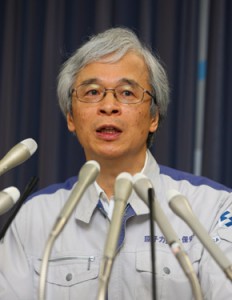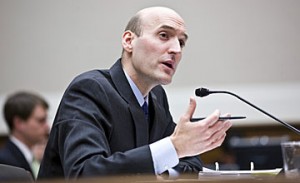Turmoil at nuclear regulatory agencies in Japan and U.S.
Japanese and U.S. counterparts face major challenges over Fukishima, but for different reasons
Life in the post-Fukushima era for nuclear regulatory agencies in Japan and the United States is not easy. In Japan, the Nuclear Industrial Safety Agency (NISA) is in hot water over revelations that it stacked the deck at public meetings with employees of the nuclear utilities it is supposed to regulate.
Two utilities told the Japanese government that they complied with requests from NISA in 2006 and 2007 to send their employees to public meetings to support proposed licensing decisions. In response to these revelations, Japanese Prime Minister Naoto Kan has questioned whether NISA should continue to exist in its present form. He also called for a phaseout of dependence on nuclear power for the Japanese economy.
In the United States, an aggressive plan to apply "lessons learned" from Fukushima to the regulation of the U.S. fleet of reactors has hit the rocks. The so-called 90-day report, supported by the controversial chairman of the U.S. Nuclear Regulatory Commission (NRC), will not be quickly acted on due to opposition from three other commissioners.
The report, and a fast timetable to implement its recommendations, has also been criticized by the Nuclear Energy Institute (NEI). It is supported by critics of nuclear energy, including Rep. Ed Markey (D., Mass.) and Sen. Barbara Boxer (D., Calif.). Yet, three of the NRC's five commissioners have voted for a more thorough review of the report, which has put a fast-track implementation schedule on hold.
Japan's nuclear regulator in role ambiguity
Public confidence by the Japanese people in the ability of the government to control the nation's nuclear reactors took a step back in late July. Revelations that beef contaminated with C-137 at levels four times higher than the regulatory limit was sold in more than 100 grocery stores created a firestorm of public response in a nation noted for its muted discourse when it comes to government authority. Worse, newly discovered radioactive hot spots outside the original 20-km evacuation zone have prompted new concerns, and the contamination has washed into sewer systems, accumulating in the sludge converted to compost and sold to gardeners across the country.
In case of pouring gasoline on a raging fire, government revealed in late July that NISA was behind efforts in 2006 and 2007 that presented a false image of widespread support for nuclear energy. Two utilities have admitted that they sent shills to public meeting in response to a request from NISA. This news follows reports that the chief executive officer of Kansai Electric ordered his employees to send e-mails to public forums on nuclear energy presenting themselves as ordinary citizens.
On July 29, the chief of the Ministry of Trade, Economy, and Industry (METI), Banri Kaieda, named two utilities that had taken these actions: Chubu Electric Power said that in 2007 it was asked by NISA to send employees to a public meeting and that they were given pro-nuclear statements to read into the record; Shikoku Electric said that in 2006 it sent a memo to employees asking them to make pronuclear statements at a public forum, and a utility spokesman told the news media it had acted on a request from NISA.
Kaieda subsequently fired the three top employees of NISA and then submitted his own resignation.
The current head of NISA, Nobuaki Terasaka, said in response that the revelations are a "serious issue" for the organization. Japanese Prime Minister Kan went further, saying that the scandal-as it is being called in the domestic press-brings into question the future existence of the agency.
The Japanese nuclear regulatory agency has been the target of withering public criticism since the March 11 earthquake and tsunami. Also, the International Atomic Energy Agency in its preliminary report on the Fukushima nuclear disaster, called for the government's nuclear regulatory function to be housed in an independent agency. It said that its current status, embedded in the trade ministry, contributed to role ambiguity as both a promoter and regulator of the nuclear industry.
On August 3, the Japanese government appears to be responding to this recommendation. A draft plan released by METI called for the function represented by NISA to be moved to the Environmental Ministry. The proposal, drafted by Goshi Hosono, who has a lead role in the government related to the Fukushima crisis, would create the independence that critics want for the oversight role. The new agency would also be responsible for investigation of future nuclear accidents.
The new agency would take over radiation-monitoring operations from the science and technology ministry. The agency's duties would include overseeing the removal of radioactive substances from contaminated soil and monitoring health effects of contamination on residents near nuclear power plants.
Chief Cabinet Secretary Yukio Edano, however, said that no decision had been made on the proposal. He added that consultations within the government and the necessary legislative change process could push the realignment into spring 2012.
U.S. Nuclear regulatory chief throws down the gauntlet
In the United States, the push to change the nuclear regulatory environment is taking a different path, but one also peppered with controversy and disagreements. NRC Chairman Gregory Jaczko threw down the gauntlet in response to "nay" votes from three other commissioners about his proposed rapid pace of implementation of the recommendations in the 90-day report based on a staff review of the Fukushima crisis. He told a congressional hearing on August 2 that delays in the implementation of lessons learned from Fukushima could impact the timing of decisions on new U.S. reactors.
In testimony to the Senate Environment & Public Works Committee, Jaczko said that the lack of quick decisions on the 90-day report's recommendations "could create uncertainty regarding what recommendations would apply to the new reactors."
California Senator Barbara Boxer, who chairs the committee, told Jaczko that she wants action on the 90-day plan as soon as possible. Boxer has opposed new nuclear plants in her home state and is generally considered to be skeptical of plans for new reactors elsewhere.
The NRC has 18 pending combined construction and operating license applications. Of that number, four reactors-two in Georgia and two more in South Carolina-are nearest a decision by the agency. Southern's CEO Tom Fanning said last week that he expects the license for the twin AP1000 reactors at the company's Vogtle site by early 2012.
Jacko's latest statement to the Senate could throw a monkey wrench in those plans. Also, it could create uncertainty among investors and even cause the Department of Energy to revise its due diligence on Southern's loan guarantee application. Southern has a conditional commitment for $8.8 billion, but the final term sheet will not be signed until it gets its NRC licenses for the two reactors.
NRC a house divided
The five-member NRC commission is divided over the timetable implementing the 90-day plan. Three of the commissioners have posted public votes on the NRC's Web site opposing quick action on it. In mid-July, commissioners William Magwood, William Ostendorff, and Kristine Svinicki all said that they wanted a more orderly and systematic approach. Magwood called for a full analytic review. Ostendorff said that he felt the current regulatory system "was not broken," and Svinicki called for a "methodical review."
The votes by the three commissioners effectively overrule Jaczko and may set the stage for similar votes on issuing final rules to grant licenses for new reactors.
The NRC report calls for "redefining the level of protection that is regarded as adequate." If that's the case, the question is just exactly what has the agency been doing up to now? This is not gratuitous skepticism. If a federal regulatory agency is moving the goal posts, then it's necessary to take a close look at its reasons for doing so.
Yet, at the same time that the NRC calls for change, it acknowledges that the information it has on what happened at Fukushima is "unavailable, unreliable, or ambiguous." This statement is most likely one of the key drivers for the dissents by the three NRC commissioners.
Even if more were known with certainty, there are lots of reasons why the 40-year-old design of the Japanese reactors at Fukushima would never be built in the current era. The task force report takes pains to point out that there is "no imminent risk" for U.S. nuclear reactors. The NRC needs to take care that it doesn't overreact to problems in Japan that don't and won't affect the U.S. fleet.
Postscript
Exelon [NYSE:EXC} CEO john Rowe told the Chicago Tribune on July 28 that he doesn't think the NRC's 90-day report is that big a deal.
"We don't at the moment see anything that has a major impact on these plants [Exelon's]," he said.
The Tribune quotes financial analyst Hugh Wynne of Sanford C. Berstein Co., Chicago, as saying that Exelon would likely sue the Department of Energy for the $723 million-$969 million cost to move spent fuel from wet storage to dry casks. The grounds would be the DOE's failure to take the fuel, as promised, and dispose of it in Yucca Mountain. Exelon responded that it is too soon to put a cost estimate on any of the regulatory changes called for by the NRC.
--------------
Dan Yurman publishes Idaho Samizdat, a blog on nuclear energy. He is a frequent contributor to ANS Nuclear Cafe.











.jpg)